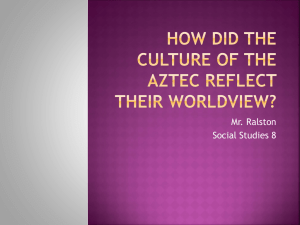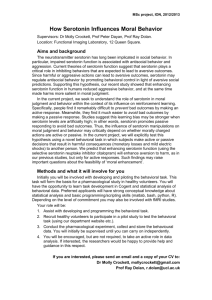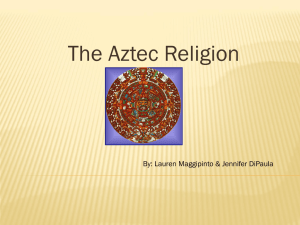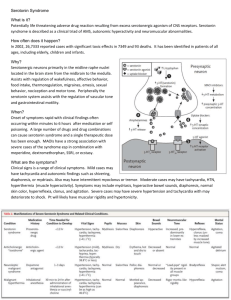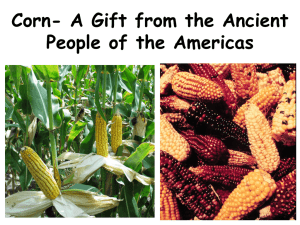Neurobiology and Aztec Cannibalism
advertisement
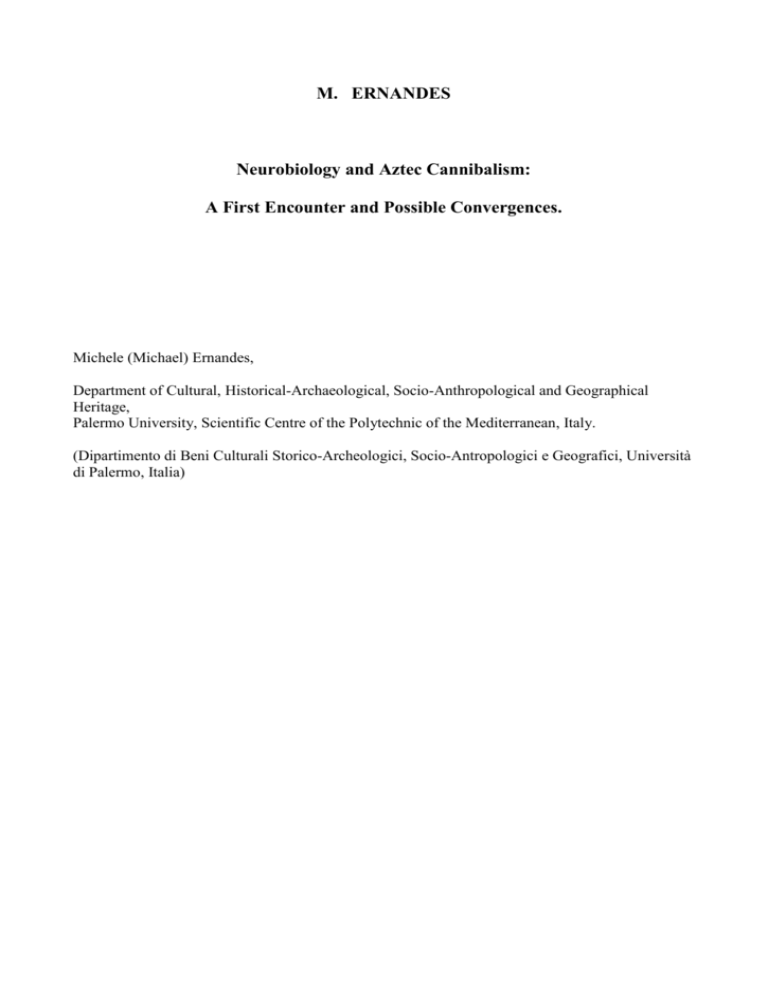
M. ERNANDES Neurobiology and Aztec Cannibalism: A First Encounter and Possible Convergences. Michele (Michael) Ernandes, Department of Cultural, Historical-Archaeological, Socio-Anthropological and Geographical Heritage, Palermo University, Scientific Centre of the Polytechnic of the Mediterranean, Italy. (Dipartimento di Beni Culturali Storico-Archeologici, Socio-Antropologici e Geografici, Università di Palermo, Italia) Abstract Neuronal synthesis of serotonin depends on the plasma “trp/Large Neutral Amino Acids” ratio, because of competition made by LNAAs against tryptophan for neuron access. “Trp/LNAAs” ratio value, in turn, tends to be correlated with amino acid composition of the diet: So a low “trp/LNAAs” ratio diet lowers brain serotonin synthesis. Serotonin deficiency involves several behavioural consequences such as tendency towards aggressive behaviour, increase of intraspecific competition, increase of magic thought or religious fanaticism. Among cereals utilised for human feeding, maize has a very low “trp/LNAAs” value. Maize was firstly and largely utilized by Native American peoples: This is particularly interesting in the study of the Aztec human sacrifice/cannibalism complex. Historical data reveal that cannibalism occurred in period of the year when maize dependence was greater, supporting the hypothesis of Ernandes and co-workers (that is here reported) that serotonin deficiency among the Aztecs might have accentuated their religious and aggressive behavior patterns on the one hand, and on the other it might have led them, unconsciously, towards anthropophagy in order to attenuate it (rising “trp/LNAAs” value by means of human proteins) when it became too strong. Introduction In the eighties of the last century, after his graduation in Natural Sciences at the University of Palermo (Italy), by a degree thesis entitled “Funzione delle Monoamine Cerebrali” (i. e. “Functions of Cerebral Monoamines”), Michele Ernandes attended the Institute of Physiology and Human Nutrition of the Pharmacy Faculty of the same University, taking part in a series of experimental works on the role of the neuromodulator (neurotransmitter) serotonin (that is a monoamine) in various animal behaviours. Meanwhile, following his interest in Anthropology, he met with Marvin Harris’ studies, and particularly with the exposition Marvin Harris had made (in “Cannibals and Kings”) of Harner’s hypothesis about the ecological motivations of Aztec cannibalism. As we know, in 1977 Harner suggested that Aztecs might have practiced cannibalism in order to obtain animal proteins, or to obtain proteins containing all amino acids in the proportions required by humans. A year later, Ortiz de Montillano objected that Aztecs could obtain all required amino acids from vegetable sources. Compared with the studies he was carrying out, Michele Ernandes judged as right Ortiz de Montillano’s criticism regarding amino acids availability for human protein synthesis, but inadequate regarding serotonin synthesis. As Fernstrom and Wurtman had shown (1971), neural synthesis of serotonin depends on the plasma ratio between the serotonin precursor, the amino acid tryptophan, and other Large Neutral Amino Acids (“trp/Large Neutral Amino Acids”, or “trp/LNAAs”), because of competition made by LNAAs against tryptophan for neuron access, since they use the same carrier to cross the blood-brain barrier. “Trp/LNAAs” ratio value, in turn, tends to be correlated with amino acid composition of the diet: So a low “trp/LNAAs” ratio diet lowers brain serotonin synthesis. Among cereals utilized for human feeding, maize has a very low “trp/LNAAs” value, and maize was the main food utilized by Mesoamerican peoples: so it is reasonable to suppose that among these peoples serotonin deficiency might occur followed by appearance or increase of behaviours connected with this deficiency. Serotonin deficiency involves several behavioural consequences such as tendency towards aggressive behaviour, increase of intraspecific competition, increase of magic thought (i. e. obsessive-compulsive disorder) or religious fanaticism, temporal lobe epilepsy, and attraction for fire. War and religious fervour were peculiarities of Mesoamerican cultures, and particularly of the Aztec one, characterized by large scale human sacrifices and cannibalism, so that Levi-Strauss (near the end of “Tristes Tropiques”) described the Aztecs as suffering from “a maniacal obsession with blood and torture”. But historical data, as that ones used by Ortiz de Montellano, reveal that cannibalism occurred in period of the year when maize dependance was greater, and so greater was serotonin deficiency. These data lead to the hypotheses that : 1) serotonin deficiency among the Aztecs might have accentuated their religious and aggressive behavior patterns on the one hand, and, on the other, 2) it might have led them, unconsciously, towards anthropophagy in order to attenuate it (rising “trp/LNAAs” value by means of human proteins) when it became too strong. The first report of these hypotheses was Ernandes’ post graduate thesis of specialization in Alimentary Sciences. At the end of 1991 this work was known by Brunetto Chiarelli, the Italian anthropologist founder and first editor in chief of the “Journal of Human Evolution”. Chiarelli called Ernandes for a paper to be published in a special issue of “Antropologia contemporanea” (a journal at time he edited) dedicated to the fifth hundredth of the discovery of the New World (Ernandes & Giammanco 1992). Some years later, Chiarelli asked Ernandes to publish on “the Mankind Quarterly” a paper about neurobiological and evolutionary origins of religion (Ernandes & Giammanco 1998). From a development of this paper, after the call made by Winkelman for the 2004 Meeting of the Society for the Scientific Study of Religion at Kansas City (Ernandes 2004a), has arisen the draft that is in this “Archive” (http://www.csr-arc.com/view.php?arc=25). In 2002 Ernandes and colleagues published on “the Mankind Quarterly” the article intitled “Aztec Cannibalism and Maize Consumption: The Serotonin Defdiciency Link”. Later, from “the Mankind Quarterly” vol. XLVI N°1 (Fall 2005), p. 135, Ernandes knew that “[d]uring the “Bell Curve wars” of the 1990s, [the Mankind Quarterly] received considerable criticism when opponents realized that many of the work cited by Herrnstein and Murray had first been published in the Mankind Quarterly.” In brief, the journal has been accused of doing foundation to racist ideas. As regards Ernandes and collegues’ article’s conclusions, they are not racist at all, as they are founded on the assumption that cerebral physiology of Mesoamerican peoples was as the common human cerebral physiology is, and so the conclusions were that cultural and behavioural peculiarities of Mesoamerican peoples were due to environmental factors (i. e. Maize based diets). On this item Ernandes presented a paper during the 2004 Meeting of SSSR at Kansas City (Ernandes 2004b) in the paper session on Sacrifice organized by Winkelman, who, in 1998, had tested Harner’s hypothesis by means of cross-cultural assessments. The article “Aztec Cannibalism and Maize Consumption: The Serotonin Defdiciency Link” is now as pdf in the web site: http://www.chronofus.net/wargames/aztecs/AztecCannibalism.pdf It is free downloadable, and we invite the reader to download it before proceeding. Comments and Notes The paper, as the published article, has some uncertain or questioning points, so we think useful to add some explanations or supplements, as the following: 1) pag. 8: as reported, Fernstrom and Wurtman wrote that “ In certain societies, large numbers of people subsist on corn [maize] diets ... Our findings on rats raise the possibility that such diets might modify the functional activity of an important set pf brain neurones in these people”. However, as we know, Fernstrom and Wurtman did not study further the effect of maize based diets on people. 2) for page 10: a more large fig. 3. "R" value, increasing the percent of other foods added to tortilla 22,000 20,000 "R" value 18,000 & beans 16,000 & human muscle & pork 14,000 &beef 12,000 10,000 8,000 0 10 20 30 40 50 60 70 80 90 100 other foods % Note that more properly the percentage must be referred to food’s proteins and not to the food as whole. 3) for page 11: a more large table I: KmW KmLNAA Maize Tortilla Beans Amaranth Human muscle Beef Pork Soft QPM Corn Flakes (human) (rat) Trp (W) Ile (I) Leu (L) Phe (F) Tyr (Y) Val (V) Met (M) His (H) Sources 1 (1) 1.111 (0.27) 0.909 (0.52) 10 (1.36) 2.308 (0.23) 0.341 (0.07) 0.588 (0.37) 0.588 (0.15) Human: 1 rat: 2 Rr (x 1000) Rn (x 1000) Rn (x 1000) (25% Phe) 2.451 2.451 5.293 6.863 6.372 a 6.462 6.907 4.902 3.428 35.232 32.061 34.351 53.399 27.481 39 b 43.372 44.066 26.717 93.130 73.282 80.995 38.931 61 b 67.661 66.621 66.412 132.387 22.424 23.030 39.835 36.364 (F+Y)a 20.994 20.994 25.160 27.5 b 29.201 26.997 24.848 36.448 19 b 22.350 22.853 20.442 20.863 38.461 41.026 65.407 35.897 47 b 51.282 55.167 45.299 52.597 12.752 12.752 8.193 18 b 19.829 21.964 12.08 15.957 17.419 15.484 21.203 [29] c 24.926 29.032 23.226 21.655 3 3 10.33 5.78 11.09 5.92 8.32 8.71 5 a: source gives F+Y in g/16gN; convertin 17.99 g in 8.41 mmol g prot. 13.26 we use pm of F 4 a: 6; b. 7 c: as pork 4 4 3 4 26.49 13.81 24.99 13.31 25.90 14.36 22.38 11.62 10.88 5.6 21.05 19.66 21.23 17.60 8.53 Sources. 1) Hargreavest & Partridge 1988. 2)Smith et al. 1987. 3) FAO 1992. 4) Belitz 1993. 5) Sanchez-Marroquin et al. 1986. 6) Millward 1999. 7) Bier 1989. Table I 4) Page 16, the sentence before the paragraph in the middle says: “The parallels between Mesoamerican human sacrifice and Christian sacrifice is plain from their artistic representations, as in figures 4 and 5”. Figures 4 and 5 are not in the published paper. They were in the draft, and are now in the next pages. For doctrinal accuracy it must be noted that in Christian crucifixion the lance equipped soldier is not a sacrificator (as the Toltec warrior, on the contrary, is): in the Christian sacrifice Jesus is at the same time victim and sacrificator. Indeed, according to Gospel, Jesus was already dead when the soldier wounded him in the chest. Fig. 4: Gold Disk H, from Chichèn Itzà (Toltec-Maya culture), the most impresive rapresentation of an human sacrifice. Fig. 5 5) At page 17 we read: “Nevertheless we cannot maintain that cannibalism or amaranth consumption entirely resolved the serotonin deficiency problem, but that at the most they mitigated it in periods when it became more grievous. We must also consider that the entire development of Aztecs’ nervous system occurred in the presence of a tryptophan deficiency during fetal development, during breast-feeding (it has been shown that milk of maize nourished mothers is trp deficient, J. J. Wurtman & Fernstrom 1979), and in infancy, when maize and beans were the main foods.” As regards the last sentence, it may be very interesting to observe if in humans it happens, or might happen, what observed in rats by the research group leaded by Limei Zhang at the University of Mexico City, and published in 2006. The paper is: Rats Subjected to Extended L-Tryptophan Restriction During Early Postnatal Stage Exhibit Anxious – Depressive Features and Structural Changes. Journal of Neuropathology and Experimental Neurology 65 (6): 562-570, and the Abstract is the following: “Serotonin transmission dysfunction has been suggested to play an important role in depression and anxiety. This study reports the results of a series of experiments in which rats were subjected to extended maize-based tortilla diets during early postnatal stages. This diet contains only approximately 20% of the L-tryptophan in normal diets of laboratory rodents. Compared with controls, experimental rats displayed a significant increase of immobility counts in the forced swimming test and exhibited anxiety-like behavior in the elevated plus maze test after 1 month of diet treatment. Low levels of serotonin contents were found in prefrontal cortex, striatum, hippocampus, and brainstem using high-performance liquid chromatography. Immunocytochemical reactions against 5-Bromo-2'-deoxyuridine revealed a significant decrease in the proliferation rate for the subgranular zone of dentate gyrus. c-Fos expression after the forced swimming test was found reduced in prefrontal cortex, dentate gyrus, CA1, and hilus of hippocampus and amygdala. Moreover, dendrite arbor atrophy and decreased spine density were evident in Golgi-Cox-impregnated CA1 pyramidal neurons. Abnormal dendrite swelling in dentate gyrus granule cells was also observed. These findings indicate an involvement of hyposerotoninergia in emotional disturbance produced by L-tryptophan restriction during critical developmental stages and suggest that neuroplasticity changes might underlie these changes.” 6) In the sixth to end line of page 18 there is a reference to a figure (fig. 6) as an example of “the orrific character of most of the Aztec divinities”. The figure of the draft was that of Coatlique, whose image is easily findable in Internet (as: http://static.panoramio.com/photos/original/511997.jpg ) 7) In the seventh and in the eighth lines of page 19 there is a reference to fig. 4, which, not reported in the paper, has been reported here above. 8) In the eleventh line of page 21 there is a reference to “fig.7”. This figure is reported in the next page. 9) For page 21, a note on the Moloch. “According to Bible, Mlk, vocalized as Molekh, was a Phoenician god to whom some Hebrews sacrificed children in Gehenn, a valley near Jerusalem. However, a god called Molekh is not quoted in any Phoenician or Punic inscription. In inscriptions, instead, is present the term “mlk”, and its meaning is “what has been sent”, referring to sacrifice’s victim (as the Latin term “Missa”, that in English becomes Mass). The victim might be a lamb (mlk ’mr, “it has been sent a lamb”), or a child (mlk ’dm, “it has been sent a child”). Victim’s killing was made by fire, and mortal remains were closed in terra-cotta urns buried in the tophets, open air sanctuaries on the heights near the cities” (Modified from Fales, 2002). It may be noted that ’dm corresponds to the Hebrew ’dm, vocalized as Adam (Uomo), so that it might be possible that mlk ’dm was not only sacrifice of child but generally of a human being. 10) Page 22: at the end of § Non Cannibalistic Rituals, we read: “These are dietary situations that, directly or indirectly, continuously or discontinously, can lead to serotonin deficiency”, or, as previously written, an excessive catecholaminergic tone. (An excessive catecholaminergic tone, due to an high tyr/LNAAs ratio, may offer a new answer to the question posed by Dohan et colleagues in 1984: “Is Schizophrenia Rare If Grain Is Rare?”). In Ancient Near East, as in ancient Greece and Rome, extreme stress circumstances led to human sacrifices. Continual wars and magic thought were common both among Greek City-States and Roman Republic. In these countries food was mostly vegetable. As reported by Dalby (2003: 213) “In the real world, those Greeks and Romans whose diet is known to us ate meat sparingly ... It is therefore misleading to suggest that Greeks only ate meat immediately after a sacrifice. In Rome there was no unbreakable link between slaughter and sacrifice and fresh meat was perhaps more prominent in the average weekly diet. Both Greeks and Romans will have eaten beef very seldom. In both cultures large games will have contributed insignificantly to most people’s diet; smaller birds were probably easier to get”. Of course, some differences are remarkable: Athenians, as other coast inhabitants, might benefit from fishing. They captured also tunnies. Fishes may have high trp/LNAAs values and/or polyunsatured fatty acids that support cerebral growth and functions. According to us, it does not seem a chance that Athenians had as main divine being Athena, at the same time a warrior and reasoning (i. e. Neocortical) goddess: perhaps Athenians unconsciously realized it, as, according to myth, Athena was born from Zeus’ head (and so mainly from Zeus’ neocortex, even if Athenians did not know what neocortex were). Spartans had a more vegetable foods dependence. Their society was rigorous, strongly ritualized and very aggressive (soldiering was the only activity of free Spartan men, or Spartiates; young men undertook night war expeditions, called “krypteia”, to kill Helots, who were subject and disarmed inhabitants near Sparta: these expeditions might be considered as passage rites or drills). Repubblican Rome was characterized by expansionist wars made mainly by citizens; in the Imperial Rome, on the contrary, citizens were forbidden to have weapons, and people liked bloody circensian games. The Emperor, as was said, gave people “panem et circenses”, i. e. “bread and circensian games”. This combination is intriguing, as we have noted that bread, owing to its amino acids composition, might reduce serotonergic tone and/or increase dopaminergic tone, and in turn these conditions might enhance aggression and intraspecific competition. We may add that, thanks to mirror neurons activity, spectators had sensation of participating in games; on the other hand, they liked bloody and grievous sights because, as said in page 19 of the paper, serotonin deficiency “reduces the capacity of identification with other people’s suffering”. In summary, serotonin deficiency enhances the capacity of identification with other people’s aggression and reduces this capacity regarding other people’s suffering. As regards religious fanaticism or fervour, the wide diffusion of Mystery Cults and Gnostic Doctrines (Burkert 1987), with their high content of magic thought, is in accordance with the existence of a widely spread serotonin deficiency (or dopaminergic overtone). 11) At page 24, before the section Imprinting–like Conditioned Behaviors, we read that “relations between triune brain and gods are summarized in fig. 10”. In the published paper this figure is, as Fig. 4, at page 25. 12) Figures 8 and 9of the original draft were as “Fig. II 5 d” and “Fig. II.5 e” are in http://www.csr-arc.com/view.php?arc=25 TABLE II: Aztec Calendar, agricultural cycle and ritual ceremonies*. Data from Ortiz de Montellano and others Christian Calendar Agricultural Ritual ceremonies Aztec month cycle Dry season 1 Atlcaualo 02/14 to 03/05 Children sacrificed to Tlaloc. 2 Tlacaxipehualiztlii Big kill (Gladiatorial sacrifice for Xipe Totec ‡); Children to Tlaloc 3 Tozozoztontli 03/26 to 04/14 Children to Tlaloc. 4 Hueytozoztli 04/15 to 05/04 Rainy season 5 Toxcatl 05/05 to 05/24 Planting of Eating of victims possible 6 Etzalcualiztli 05/25 to 06/13 but not mentioned. corn 7 Tecuilhuitontli 06/14 to 07/03 8 Hueytecuilhuitl 07/04 to 07/23 Time of scarcity 9 Miccailhuitl 07/24 to 08/12 10 Xocotlhuetzi 08/13 to 09/01 Fruit harvest No killing, no victims eaten. 11 Ochpaniztli 09/02 to 09/21 Harvest feast (Woman sacrificed ‡‡). 12 Teotleco 09/22 to 10/11 13 Tepeilhuitl 10/12 to 10/31 Corn Big kill and eating. 14 Quecholli 11/01 to 11/20 harvest Large wild game hunt, captives sacrificed and eaten.# Dry Season 15 Panquetzaliztli 11/12 to 12/10 ## Corn Biggest kill and eating. 16 Atemoztli 12/11 to 12/30 ## No victims eaten; Eating of amaranth idols. ## harvest 17 Tititl 12/31 to 01/19 Eating of victims possible but not mentioned. 18 Izcalli 01/20 to 02/08 No victims eaten; Eating of amaranth dishes.## (Nemontemi) 02/09 to 02/13 * Ritual ceremonies were celebrated at the end of Aztec month (Krickeberg 1959). ‡ Hassig 1988. ‡‡ Brown 1984. # Datum from Ortiz de Montellano’s article (1978), but not in its table. ## Amaranth harvest or eating (Martinez 1936). Aztec months 1, 2, 3 and 4 : from medium to low corn availability. Aztec months 5, 6, 7, 8, 9, 10, 11 and 12: from low to very low corn availability. Aztec months 13, 14, and 15: Aztec months 16, 17, and 18: hign corn availability. high corn availability, but eating of amaranth. References. Burkert W. 1987 Ancient Mystery Cults. Cambridge: Harvard University Press. Dalby A. 2003 Food in the Ancient World from A to Z. London and New York: Routledge. Dohan F. C., Harper E. H., Clark M. H., Rodrigue R. B., Zigas V. 1984 Is Schizophrenia Rare If Grain Is Rare? Biological Psychiatry 19 (3): 385-399. Ernandes M. 2004a The Triune Brain as Neurobehavioral Basis of God Concept. 2004 Meeting of the Society for the Scientific Study of Religion, Kansas City (Missouri), October 21-24. 2004b Neurobiology of Sacrificial Rites. 2004 Meeting of the Society for the Scientific Study of Religion, Kansas City (Missouri), October 21-24. The Program Schedule of above mentioned Meeting is at: http://www.sssrweb.org/2004meeting.pdf Abstracts are in: http://rra.hartsem.edu/2004abstracts.pdf Ernandes M, Giammanco S 1992 A serotonin deficiency hypothesis explaining the Aztec human sacrifice/cannibalism complex. Antropologia contemporanea 15: 65-73. 1998 MacLean’s Triune Brain and the Origin of the “Immense Power Being” Idea. The Mankind Quarterly 39 (2): 173-201. Fales F. M. 2002 Moloch, in: NOVA, Enciclopedia UTET, vol. VII, pages 119-120. Torino (Turin): UTET. Fernstrom J. D., Wurtman R. J. 1971 Effect of Chronic Corn Consumption on Serotonin Content of Rat Brain. Nature New Biology 234: 62-64. Harner M. 1977 The ecological basis for Aztec sacrifice. American Ethnologist 4: 117-135. Harris M. 1977 Cannibals and Kings: The Origins of Cultures. New York: Random House. Ortiz de Montellano B. R. 1978 Aztec cannibalism: an ecological necessity? Science 200: 611-617. Winkelman M. 1998 Aztec human sacrifice: Cross-cultural assessments of the ecological hypothesis. Ethnology 37: 285-298. Zhang L., Guadamarra L., Corona-Morales A. A., Vega-Gonzalez A., Rocha L., Escobar A. 2006 Rats Subjected to Extended L-Tryptophan Restriction During Early Postnatal Stage Exhibit Anxious – Depressive Features and Structural Changes. Journal of Neuropathology and Experimental Neurology 65 (6): 562-570.

